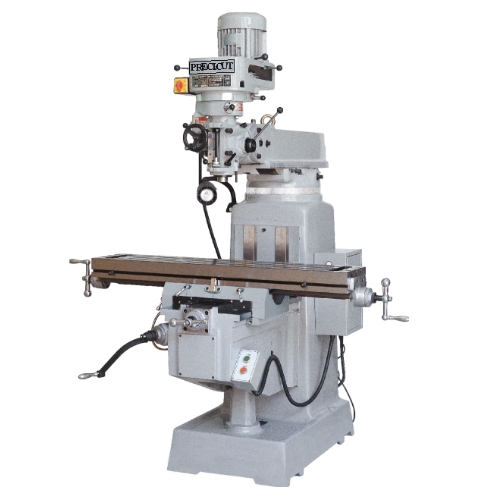blob-article

Milling machines form an important component in modern metalworking and prototyping, used for precise cutting, shaping, and drilling of metals for several industrial works. In the past few years, milling machines have gone through significant transformation, catering to different manufacturing requirements. Leading manufacturers of milling machines continue to advance and provide refined solutions, rendering metalworking more efficient and precise.
Understanding Conventional Milling Machines
Classic milling machines have long been the foundation of manufacturing. Unlike modern machines, these human-operated tools rely on skilled machinists to control the cutting action. They are widely used in workshops and factories where precision and customization must be achieved without resorting to computer programming. Conventional milling machines are cost-saving and easy to apply, hence they are appropriate for varied machining operations where the process has to be applied by hand.
Among conventional milling machines, two stand out: the horizontal milling machine and the universal milling machine.
Horizontal Milling Machines: Enhancing Efficiency
There is also a horizontal milling machine that has a horizontally positioned pin used in utilizing a number of cutting tools at a time. The machine is best for heavy-duty operations such as cutting bulk metal parts, slotting, and gear cutting. Horizontal positioning is advantageous in providing stability and high material removal rates, hence popular among industries handling bulk metal fabrication.
Important characteristics of Horizontal Milling Machines:
- Accurate design for processing of heavy workpieces
- Multi-cutting tool to improve productivity
- Suitable for heavy metal cutting and slotting operations
- High material removal rate to provide efficient machining
- Used in sectors like automotive, aerospace, and large machinery production
When working on hard metals such as steel and titanium horizontal milling machines are best suited. Horizontal positioning allows more effective evacuation of chips, with less chance of overheating and greater tool durability. Moreover, their capacity for heavier and bulkier workpieces makes them absolutely essential in high-production manufacturing.
Universal Milling Machines: Versatility in Machining
A universal milling machine provides more flexibility than other conventional milling machines. It has a rotating table through which the workpiece is placed at different angles, hence ideal for complicated machining operations. This flexibility provides universal milling machines essential in tool rooms, workshops, and manufacturing units.
Key Benefits of Universal Milling Machines:
- Adjustable table for angular and helical machining
- Ideal for different types of materials and intricate geometries
- Applied in mold making, precision engineering, and repair works
- Offers versatility in metalworking applications
- Facilitates simultaneous machining processes, including slotting, drilling, and contouring
The ability of universal milling machines to cut multi-angle increases its applications in complicated projects. It finds application in high-precision industries like die making and mold and is a requisite machine in making complicated metal pieces. Its ability to adjust small things makes it a very viable option for applications in prototyping.
Why opt for Conventional Milling Machines?
While contemporary technology has become fashionable, old-fashioned milling machines are still of value because they are economical, easy to use, and reliable. They are of most use in small industries, repair workshops, and engineering schools where hand operation and tailor-making are important.
Things to Consider While Selecting a Milling Machine:
- Type of workpiece and machining requirement
- Accuracy and adaptability required for machining
- Machine longevity and maintenance convenience
- Presence of skilled operators for manual operation
- Budget issues and long-term operating expenses
Traditional milling machines provide a tactile experience that enables machinists to adjust their workpieces by hand, so they are particularly suited for jobs that demand great manual accuracy. Moreover, their affordability in comparison to modern milling machine equipment makes them affordable for more people.
The Importance of Milling Machine Manufacturers
High-end milling machine companies emphasize the development of quality, long-lasting, and efficient machines that suit various industrial demands. These companies constantly upgrade their products by incorporating innovative materials, enhanced ergonomics, and better safety functions. A purchase of a milling machine from a reliable company promises longevity, accuracy, and improved performance for machining processes.
Important Features in Contemporary Conventional Milling Machines:
- Better material make-up for greater durability
- Better safety features, such as emergency stops
- Precision dials and micrometers for precise cutting
- Effective lubrication systems to minimize wear and tear
- Optional digital readouts for improved control and monitoring
Milling machine manufacturers are also meeting industry needs by adding semi-automated features that combine conventional milling operations with contemporary efficiency improvements, keeping these machines competitive in today's manufacturing environment.
Applications of Conventional Milling Machines
Both universal milling machines and horizontal milling machines are used in a broad spectrum of industries. Some of the most popular uses are:
- Automotive Industry: Employed for the production of engine parts, gearboxes, and transmission systems
- Aerospace Industry: Suitable for machining high-strength metal alloys employed in aircraft structures
- Metal Fabrication Workshops: Used for bending large metal sheets, slot cutting, and making complex designs
- Tool and Die Making: Used for making molds and high-precision parts
Conclusion
Milling machines form the core of the metal industry, and their application in manufacturing and prototyping cannot be exaggerated. While horizontal milling machines bring stability and effectiveness for heavy machining, universal milling machines offer unsurpassed versatility for intricate operations.
Leading milling machine manufacturers keep upgrading conventional machines to meet the needs of modern manufacturing. For prototyping large quantities or specialty production, traditional milling machines continue to be a must-have equipment in industries globally. With technological advances refining the efficacy and precision of the equipment regularly, these will remain an invaluable resource in metalwork and prototyping for years to come.

